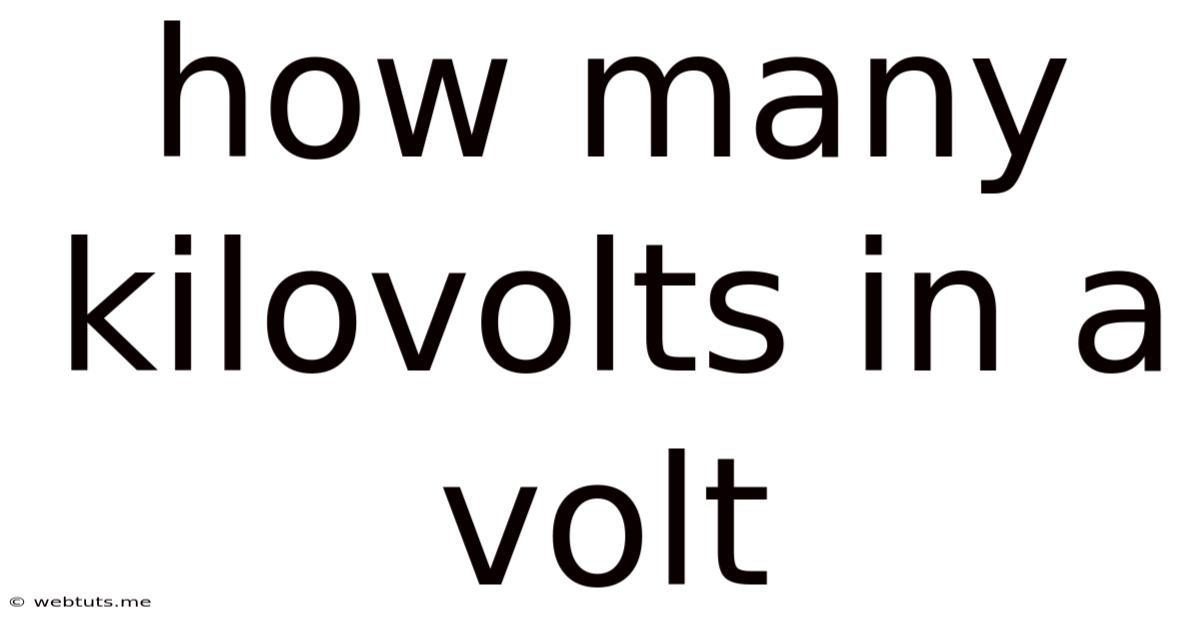How Many Kilovolts In A Volt
Webtuts
May 12, 2025 · 4 min read

Table of Contents
How Many Kilovolts in a Volt? Understanding Voltage and its Prefixes
The question "How many kilovolts in a volt?" might seem deceptively simple, but it opens the door to a deeper understanding of voltage, its measurement, and the metric prefixes used in electrical engineering and physics. This comprehensive guide will not only answer this question definitively but also explore the broader context of voltage, its significance, and related concepts.
Understanding Voltage: The Driving Force of Electricity
Voltage, also known as electromotive force (EMF) or potential difference, is the pressure that pushes electrons through a conductor, such as a wire. It's the driving force behind electric current, much like water pressure pushes water through a pipe. The higher the voltage, the greater the pressure, and consequently, the greater the potential for current flow.
We measure voltage in volts (V), named after Alessandro Volta, a pioneer in the field of electricity. A volt is defined as the potential difference between two points in an electric circuit that will impart one joule of energy to one coulomb of charge. While this definition might seem technical, it essentially highlights the relationship between energy, charge, and voltage.
Kilovolts (kV) and other prefixes: Scaling Voltage
The volt, while a practical unit, isn't always the most convenient for expressing very large or very small voltages. This is where metric prefixes come into play. These prefixes multiply or divide the base unit (in this case, the volt) by powers of 10, making it easier to express extremely large or small values.
Kilovolt (kV) is one such prefix. "Kilo" means one thousand, so:
1 kilovolt (kV) = 1000 volts (V)
Therefore, to find out how many kilovolts are in a given number of volts, simply divide the number of volts by 1000.
For instance:
- 5000 volts = 5 kilovolts
- 10,000 volts = 10 kilovolts
- 1,000,000 volts = 1000 kilovolts
Other Relevant Prefixes in Voltage Measurement:
Beyond kilovolts, other prefixes are frequently used depending on the scale of the voltage being discussed:
- Megavolt (MV): 1 MV = 1,000,000 V (1 million volts) - often used in high-voltage power transmission.
- Gigavolt (GV): 1 GV = 1,000,000,000 V (1 billion volts) - used in extremely high-voltage applications, such as some research experiments.
- Millivolt (mV): 1 mV = 0.001 V (one-thousandth of a volt) – commonly found in low-voltage electronics and measurements.
- Microvolt (µV): 1 µV = 0.000001 V (one-millionth of a volt) - used in extremely sensitive measurements.
- Nanovolt (nV): 1 nV = 0.000000001 V (one-billionth of a volt) - found in highly specialized scientific instruments.
Understanding these prefixes is crucial for comprehending technical specifications and data related to electricity and electronics.
Practical Applications of Kilovolts and other Voltage Scales:
The choice of voltage scale depends heavily on the application. Here are some examples:
High Voltage Applications (kV and above):
- Power Transmission: High-voltage transmission lines typically operate at hundreds of kilovolts to efficiently transmit electricity over long distances. The higher the voltage, the lower the current for the same power, resulting in reduced energy loss due to resistance.
- Medical Imaging (X-rays, CT scans): These machines utilize kilovolts to generate the high-energy X-rays required for medical imaging.
- Particle Accelerators: These devices accelerate charged particles to extremely high speeds using megavolts and even gigavolts.
- Lightning: A single lightning bolt can have a voltage in the range of tens or even hundreds of megavolts.
Low Voltage Applications (mV and below):
- Biomedical Sensors: These devices measure tiny voltage changes in biological systems, often working in the millivolt or even microvolt range.
- Microelectronics: Integrated circuits (ICs) and other microelectronic components operate at very low voltages, typically in the range of volts or millivolts.
- Signal Processing: Weak signals, such as those from microphones or antennas, are often measured in millivolts or microvolts.
Safety Considerations when Working with High Voltage:
Working with high voltages, particularly those in the kilovolt range and above, presents significant safety risks. Always exercise extreme caution and follow appropriate safety procedures. Improper handling of high voltage can lead to severe electric shock, burns, and even death.
Key safety precautions include:
- Proper training: Only qualified personnel should handle high-voltage equipment.
- Insulation and protective gear: Wear appropriate protective clothing, including insulated gloves and safety glasses.
- Lockout/Tagout procedures: Properly de-energize equipment before working on it.
- Grounding: Ensure proper grounding to prevent electrical shock.
Conclusion: Beyond the Simple Conversion
While the answer to "How many kilovolts in a volt?" is a straightforward 1/1000, the broader context of voltage and its various scales is far more nuanced. Understanding the role of voltage in various applications, along with the importance of safety precautions when dealing with high voltages, is critical for anyone working with electricity or related technologies. From the minuscule voltages in microelectronics to the immense voltages in power transmission and lightning, voltage remains a fundamental concept in our understanding and application of electricity. Mastering the metric prefixes and their application ensures clear communication and safe operation in the world of electrical engineering and beyond.
Latest Posts
Related Post
Thank you for visiting our website which covers about How Many Kilovolts In A Volt . We hope the information provided has been useful to you. Feel free to contact us if you have any questions or need further assistance. See you next time and don't miss to bookmark.